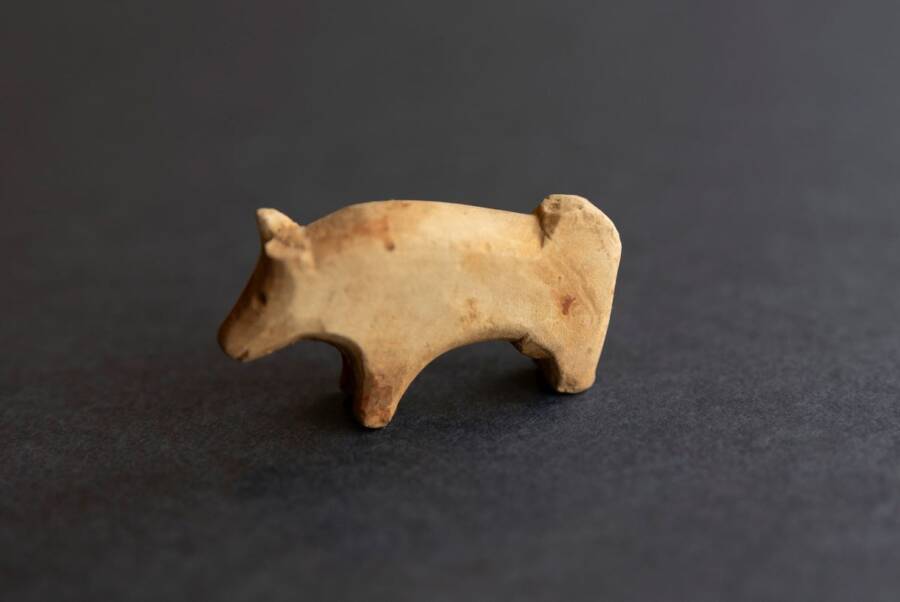In a remote corner of Iceland, tucked away in the village of Seyðisfjörður, an incredible discovery was made: a small, carved figurine, likely a child’s toy from the medieval era. This isn’t just any find. It’s something special. Carved from volcanic tuff— a soft rock formed from volcanic ash—this tiny object, measuring under two inches long, has been remarkably well-preserved despite being centuries old.
The figurine’s shape is simple, yet intriguing. It appears to resemble an animal, possibly a bear or a boar, though some have suggested it could be an Icelandic dog. The figurine’s exact identity is still being debated by the archaeologists who uncovered it. But whatever animal it represents, this tiny artifact has left experts buzzing. Why? Because finding toys at archaeological sites is rare, and finding one in such pristine condition is even rarer.
A Glimpse into Medieval Childhood
This find takes us back nearly 1,000 years to a time when the village of Seyðisfjörður, like much of Iceland, was shaped by volcanic activity and the rugged lifestyle of its people. While we often think of Viking Age and medieval Iceland in terms of fierce warriors, seafaring expeditions, and harsh living conditions, this discovery reminds us that there were also moments of joy, play, and perhaps even boredom for the children of the time. Yes, even Viking kids had toys!
Lead archaeologist, Ragnheiður Traustadóttir, and her team have been working at the site for several years now. In fact, excavations at Seyðisfjörður began in 2020, and since then, more than 600 artifacts have been uncovered. These artifacts date from 940 to 1100 CE, a period when Iceland was transitioning from a pagan Viking society to a Christian one. Among these finds are game pieces, pearls, and a colorful bead featuring the colors of the modern Icelandic flag—blue, red, and white. And yet, it’s this little toy that has truly captured imaginations.
The Art of Play in Ancient Iceland
The toy—thought to have been used by a child centuries ago—helps fill in a gap in our understanding of medieval life. It’s easy to overlook the simple moments, like children playing or the items they held dear, when studying ancient societies. But toys offer a unique insight into those quieter, more personal aspects of life.
Consider this: toys serve as a universal element in human history. From the carved figurines of ancient Egypt to the clay dolls of Greece and Rome, children have always found ways to play, no matter the era or location. In Iceland, where the landscape is shaped by fire and ice, it’s fascinating to think about a child in the 10th century, carving out their own moments of joy, perhaps even pretending this little figurine was a fierce bear or a loyal dog.
In interviews, Traustadóttir said that while it’s unusual to find toys in such good condition, it’s “entirely logical,” because children existed in this period, just as in any other(Archeology News).
However, what makes this toy stand out is the volcanic tuff material. Volcanic ash and lava are significant features of Iceland’s geology, and to find a toy carved from such material is a wonderful reminder of how people used the natural resources around them, even in playful ways.
More Than Just a Toy
But this figurine isn’t the only fascinating find from Seyðisfjörður. Since the excavation began, archaeologists have been uncovering a treasure trove of medieval Icelandic artifacts. In addition to the figurine, more than 70 fragments of chess pieces were found this past summer, adding to the growing collection of game-related items from the site(Archaeology News Online Magazine).
Earlier digs unearthed pieces from a game called “boxing,” which was played in Iceland from the Viking Age through the Middle Ages, though the exact rules of the game have been lost to time.
Other discoveries include a pit filled with bones, including whale bones, that had been carefully demarcated with stones. It’s unclear if the pit was used as a form of trash disposal or if it served another purpose, but this too has captured the interest of historians.
These finds offer a broader picture of life in Seyðisfjörður during the medieval period— a life that was both practical and playful.
Iceland’s Unique Archaeological Landscape
One thing that makes Iceland a particularly rich place for archaeological study is its layers of volcanic ash, which serve as a sort of historical timestamp. Every time a volcano erupted, the ash settled over the land, creating distinct layers in the soil. By studying these layers, archaeologists can precisely date artifacts. For instance, the figurine found in Seyðisfjörður is thought to date from a period between 940 and 1100 CE, based on the layers of ash it was buried under.
This method of dating has proven invaluable in Iceland, where the interplay between human activity and volcanic eruptions is a defining feature of history. The volcanic tuff that makes up this toy not only points to Iceland’s geological makeup but also highlights the resourcefulness of its people, who used the land’s natural elements to create everyday objects, from toys to tools.
A Window into the Past
So what can we learn from this tiny toy? First and foremost, it’s a reminder that despite the passage of centuries, some things remain the same. Children have always played with toys, whether they’re made from wood, clay, or volcanic rock. These small items might seem insignificant compared to grand discoveries of weapons or shipwrecks, but they offer a deeply human connection to the past.
It’s also a testament to the resilience of ancient craftsmanship. The fact that this toy has survived in such good condition for so long speaks to the skill of whoever made it. And while we may never know for sure if it was meant to represent a bear, a boar, or something else entirely, the fact that it has sparked such debate is a testament to its unique charm.
As excavations continue at Seyðisfjörður, who knows what other treasures might be waiting to be uncovered? For now, this small figurine stands as a symbol of life’s quieter moments—a snapshot of a child’s playtime in medieval Iceland, preserved for nearly a millennium beneath layers of volcanic ash(
In the world of archaeology, it’s often the unexpected finds, like this little toy, that leave the biggest impression.

